Eco-Efficiency in Measuring the Sustainable Production of Agricultural Crops
Abstract
1. Introduction
2. Materials and Methods
- The purpose, system boundaries, assumptions, limitations and functional unit were determined.
- The set of input and output data was analyzed: data on the quantity and quality of materials and energy consumed were collected, as well as data on production results and estimated emissions. In this phase the life cycle inventory was made. All inputs and emissions were compiled and converted to a common functional unit. These data formed the basis for the LCIA assessment.
- The classification and characterization procedure was performed (after selecting the category and category indicators). An important step in this phase is the evaluation of the potential environmental impact of the various emissions and resource consumption. Based on the characterization factors for emissions quantified in the inventory, aggregation of the masses per functional unit into one figure of impact category indicator was carried out. The formula for calculating the indicators of different impact categories is given in the following equation:where Icat is the indicator result for the impact category, Mi is the mass of consumed or emitted substance i assigned to the given impact category during classification (kg i per functional unit) and CFcati is the characterization factor for the given substance i.
- The results were interpreted and conclusions drawn in line with the previously set study objective.
3. Results
4. Discussion
5. Conclusions
Author Contributions
Funding
Conflicts of Interest
References
- Piontek, B. Koncepcja Rozwoju Zrównoważonego i Trwałego Polski; PWN: Warszawa, Poland, 2002. [Google Scholar]
- Woś, A.; Zegar, J.S. Rolnictwo Społecznie Zrównoważone; IERiGŻ: Warszawa, Poland, 2002. [Google Scholar]
- Runowski, H. Systemy rolnictwa w scenariuszu przyszłości. In Polska Wieś 2025. Wizja Rozwoju; Wilkin, J., Ed.; IRWiR PAN: Warszawa, Poland, 2005. [Google Scholar]
- Baum, R.; Wielicki, W. Prognoza przeobrażeń w rolnictwie do roku 2030 w kontekście zrównoważonego rozwoju. Wieś i Rolnictwo 2007, 1, 19–32. [Google Scholar]
- Baum, R. Ocena Zrównoważonego Rozwoju w Rolnictwie (Studium Metodyczne); Rozprawy Naukowe 434; Uniwersytet Przyrodniczy w Poznaniu: Poznań, Poland, 2011. [Google Scholar]
- Prus, P. Perspectives for Sustainable Development of Agricultural and Rural Areas. In Ecosystem Health and Sustainable Agriculture 1. Sustainable Agriculture; Jakobsson, C., Ed.; Uppsala University: Uppsala, Sweden, 2012; pp. 51–59. [Google Scholar]
- Prus, P.; Mejszelis, M. Multifunctional development of rural areas in terms of the concept of sustainable development. In Human and Nature Safety, Proceedings of the International Scientific Conference, Vilnius, Lithuania, 16–17 May 2012; Aleksandras Stulginskis University: Kaunas, Lithuania, 2012; pp. 112–115. [Google Scholar]
- Łuczka, W.; Smoluk-Sikorska, J. Sustainable consumption–between theory and practice. In Proceedings of the 8th International Scientific Conference Rural Development 2017, Kaunas, Lithuania, 23–24 November 2017; pp. 1–6. [Google Scholar]
- Prus, P. Sustainable farming production and its impact on the natural environment-case study based on a selected group of farmers. In Proceedings of the 8th International Scientific Conference Rural Development 2017, Kaunas, Lithuania, 23–24 November 2017; pp. 1280–1285. [Google Scholar]
- Baum, R.; Bieńkowski, J. Eco-efficiency as Part of Sustainable Farm Development. Folia Oeconomica. Acta Univ. Lodz. 2019, 2, 23–42. [Google Scholar] [CrossRef][Green Version]
- Goedkoop, M.J.; Heijungs, R.; Huijbregts, M.; De Schryver, A.; Struijs, J.; Van Zelm, R. ReCiPe 2008, A Life Cycle Impact Assessment Method Which Comprises Harmonised Category Indicators at the Midpoint and the Endpoint Level. First Edition Report I: Characterisation; Ministerie van Volkshuisvesting, Ruimtelijke Ordening en Milieubeheer: Hague, The Netherlands, 2013. [Google Scholar]
- Rebitzer, G.; Ekvall, T.; Frischknecht, R.; Hunkeler, D.; Norris, G.; Rydberg, T.; Schmidt, W.-P.; Suh, S.; Weidema, B.P.; Pennington, D.W. Life cycle assessment. Part 1: Framework, goal and scope definition, inventory analysis and applications. Environ. Int. 2004, 30, 701–720. [Google Scholar] [CrossRef] [PubMed]
- Lozano, S.; Iribarren, D.; Moreira, M.T.; Feijoo, G. The link between operational efficiency and environmental impacts. A joint application of Life Cycle Assessment and Data Envelopment Analysis. Sci. Total Environ. 2009, 407, 1744–1754. [Google Scholar] [CrossRef] [PubMed]
- PKN PN-EN ISO 14040. Environmental Management. Life Cycle Assessment. Principles and Framework; ISO: Warszawa, Poland, 2006. [Google Scholar]
- Dong, G.; Mao, X.; Zeng, A. Carbon footprint accounting and dynamics and the driving forces of agricultural production in Zhejiang Province, China. Ecol. Econ. 2013, 91, 38–47. [Google Scholar] [CrossRef]
- Shrestha, B.M.; Desjardins, R.L.; McConkey, B.G.; Worth, D.E.; Dyer, J.A.; Cerkowniak, D.D. Change in carbon footprint of canola production in the Canadian Prairies from 1986 to 2006. Renew. Energy 2013, 63, 634–641. [Google Scholar] [CrossRef]
- Brandão, M.; Levasseur, A.; Kirschbaum, M.U.K.; Weidema, B.P.; Cowie, A.L.; Jørgensen, S.V.; Hauschild, M.Z.; Pennington, D.W.; Chomkhamsri, K. Key issues and options in accounting forcarbon sequestration and temporary storage in life cycle assessment and carbon footprinting. Int. J. Life Cycle Assess. 2013, 18, 230–240. [Google Scholar] [CrossRef]
- European Council Conclusions 2014. 2030 Climate and Energy Policy Framework. Conclusions. 23/24 October 2014, EUCO 169/14. Available online: http://www.consilium.europa.eu/uedocs/cms_data/docs/pressdata/en/ec/145397.pdf (accessed on 21 July 2019).
- Brentrup, F.; Küsters, J.; Kuhlmann, H.; Lammel, J. Environmental impact assessment of agricultural production systems using the life cycle assessment methodology. I. Theoretical concept of a LCA method tailored to crop production. Eur. J. Agron. 2004, 2, 247–264. [Google Scholar] [CrossRef]
- Heijungs, R.; Settanni, E.; Guinée, J. Toward a computational structure for life cycle sustainability analysis: Unifying LCA and LCC. Int. J. Life Cycle Assess. 2013, 18, 1722–1733. [Google Scholar] [CrossRef]
- Bieńkowski, J.; Baum, R.; Holka, M. Life cycle assessment and life cycle costing in measuring the eco-efficiency of winter rape production. Conference paper (Book of Abstracts). In Proceedings of the 49th International Academic Conference, Dubrovnik, Croatia, 27–30 August 2019; pp. 23–24. [Google Scholar] [CrossRef]
- Bieńkowski, J.; Baum, R.; Holka, M. Life cycle assessment and life cycle costing in measuring the sustainability performance of maize production. Conference paper (Book of Abstracts). In Proceedings of the 7th International Conference on Sustainable Development, Rome, Italy, 4–5 September 2019; pp. 142–143. Available online: Https://ecsdev.org/images/conference/7thICSD2019/Proceedings-abstracts-7ICSDpdf (accessed on 11 January 2020).
- European Commission-Joint Research Centre-Institute for Environment and Sustainability. International Reference Life Cycle Data System (ILCD) Handbook-Recommendations for Life Cycle Impact Assessment in the European Context; Publications Office of the European Union: Luxemburg, 2011. [Google Scholar]
- Rebitzer, G.; Seuring, S. Methodology and application of life cycle costing. Int. J. Life Cycle Assess. 2003, 8, 110–111. [Google Scholar] [CrossRef]
- Guinée, J.B.; Gorrée, M.; Heijungs, R.; Huppes, G.; Kleijn, R.; de Koning, A.; van Oers, L.; Wegener Sleeswijk, A.; Suh, S.; Udo de Haes, H.A.; et al. Handbook on Life Cycle Assessment. Operational Guide to the ISO Standards. I: LCA in Perspective. IIa: Guide. IIb: Operational Annex. III: Scientific Background; Kluwer Academic Publishers: Dordrecht, The Netherlands, 2002. [Google Scholar]
- IPCC 2006. 2006 IPCC Guidelines for National Greenhouse Gas Inventories. Volume 2 Energy. Task Force on National Greenhouse Gas Inventories. Available online: http://www.ipcc-nggip.iges.or.jp/public/2006gl/vol2.html (accessed on 27 May 2019).
- What Is a Carbon Footprint–Definition. Available online: https://timeforchange.org/what-is-a-carbon-footprint-definition/ (accessed on 3 January 2020).
- BSI 2011. PAS 2050: Specification for the Assessment of the Life Cycle Greenhouse Gas Emissions of Goods and Services; British Standards Institute: London, UK, 2011. [Google Scholar]
- Milà i Canals, L.; Sim, S.; García-Suárez, T.; Neuer, G.; Herstein, K.; Kerr, C.; Rigarlsford, G.; King, H. Estimating the greenhouse gas footprint of Knorr. Int. J. Life Cycle Assess. 2011, 16, 50–58. [Google Scholar] [CrossRef]
- Jayasundara, S.; Wagner-Riddle, C.; Dias, G.; Kariyapperuma, K.A. Energy and greenhouse gas intensity of corn (Zeamays L.) production in Ontario: A regional assessment. Can. J. Soil Sci. 2014, 94, 77–95. [Google Scholar] [CrossRef]
- Iriarte, A.; Rieradevall, J.; Gabarrell, X. Life cycle assessment of sunflower and rapeseed as energy crops under Chilean conditions. J. Clean. Prod. 2010, 18, 336–345. [Google Scholar] [CrossRef]
- Gasol, C.M.; Salvia, J.; Serra, J.; Antón, A.; Sevigne, E.; Rieradevall, J.; Gabarrell, X. A life cycle assessment of biodiesel production from winter rape grown in Southern Europe. Biomass Bioenergy 2012, 40, 71–81. [Google Scholar] [CrossRef]
- Krzyżaniak, M.; Stolarski, M.; Śnieg, M.; Christou, M.; Alexopoulou, E. Life cycle assessment of Crambe abyssinica production for an integrated multi-product biorefinery. Environ. Biotechnol. 2013, 9, 72–80. [Google Scholar] [CrossRef][Green Version]
- MAF. Carbon Footprint of New Zealand Arable Production–Wheat, Maize. Silage, Maize Grain and Ryegrass Seed; Technical Paper; New Zeland’s Ministry of Agriculture and Forestry: Wellington, New Zealand, 2011.
- Kim, S.; Dale, B.E.; Jenkins, R. Life cycle assessment of corn grain and corn stover in the United States. Int. J. Life Cycle Assess. 2009, 14, 160–174. [Google Scholar] [CrossRef]
- Williams, A.G.; Audsley, E.; Sandars, D.L. Determining the Environmental Burdens and Resource Use in the Production of Agricultural and Horticultural Commodities; Main Report. Defra Research Project IS0205; Cranfield University and Defra: Bedford, UK, 2006; Available online: http://www.defra.go.uk (accessed on 17 June 2019).
- Huerta, J.H.; Alvear, E.M.; Navarro, R.M. Evaluation of two production methods of Chilean wheat by life cycle assessment (LCA). IDESIA 2012, 30, 101–110. [Google Scholar] [CrossRef][Green Version]
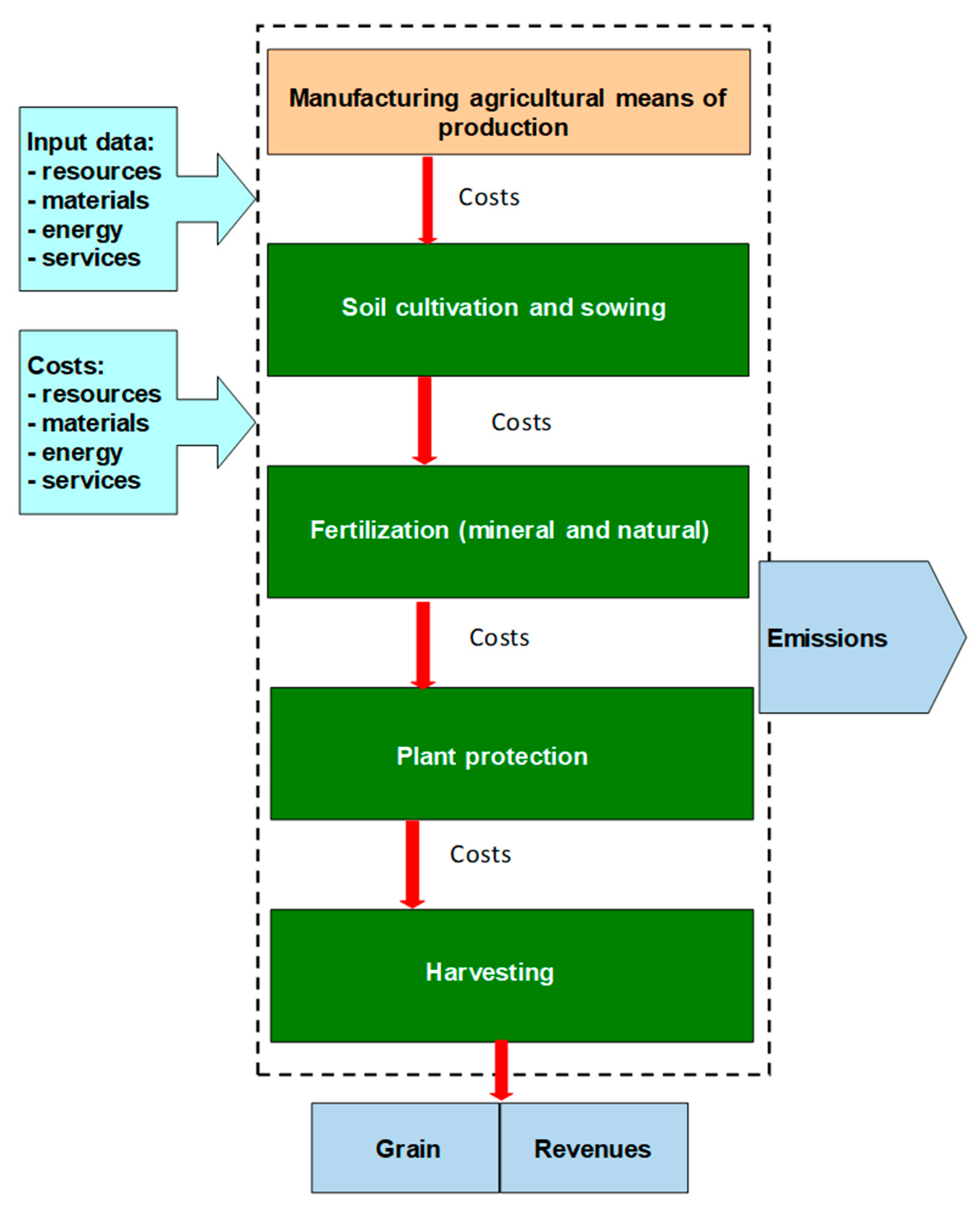
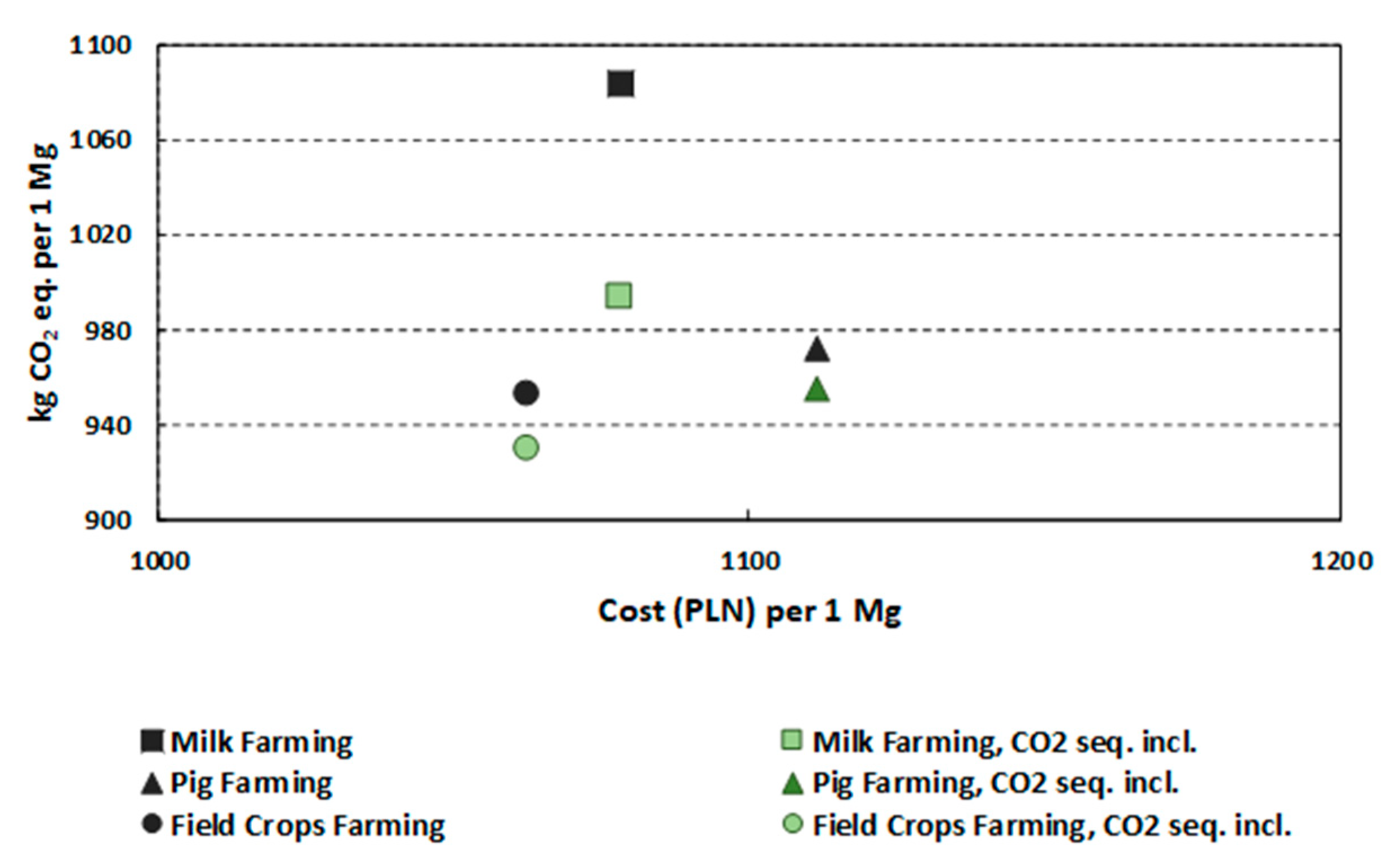
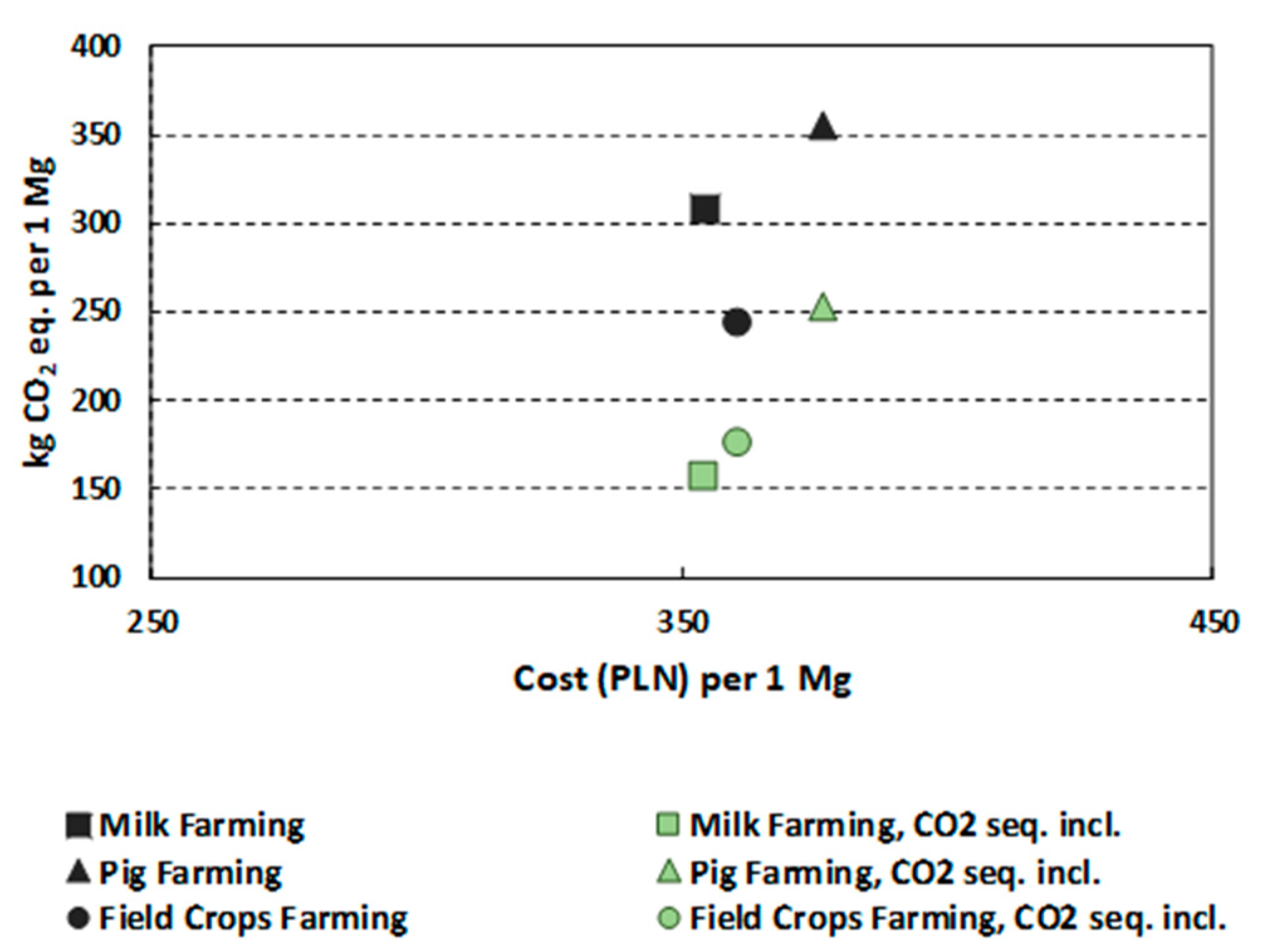
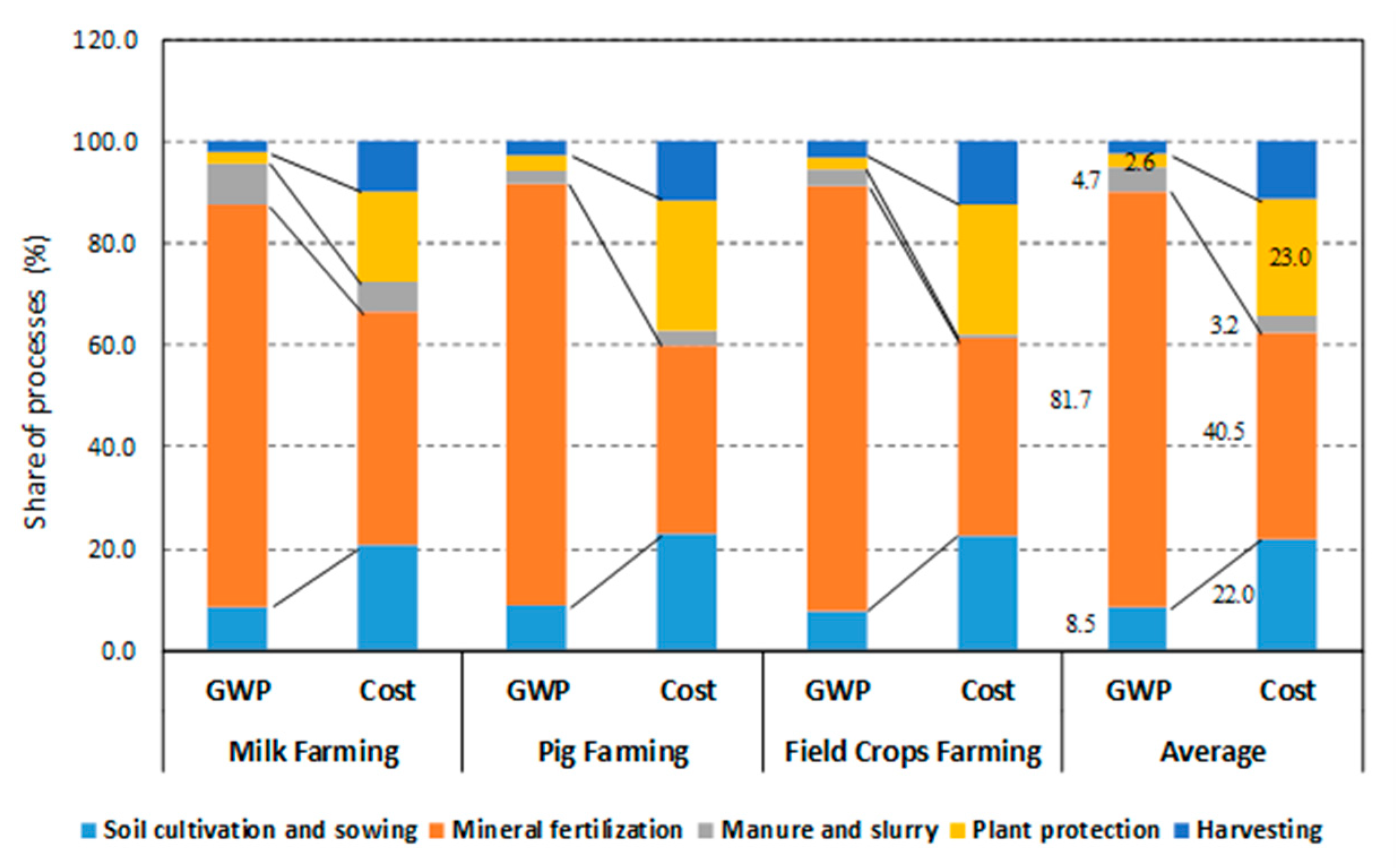
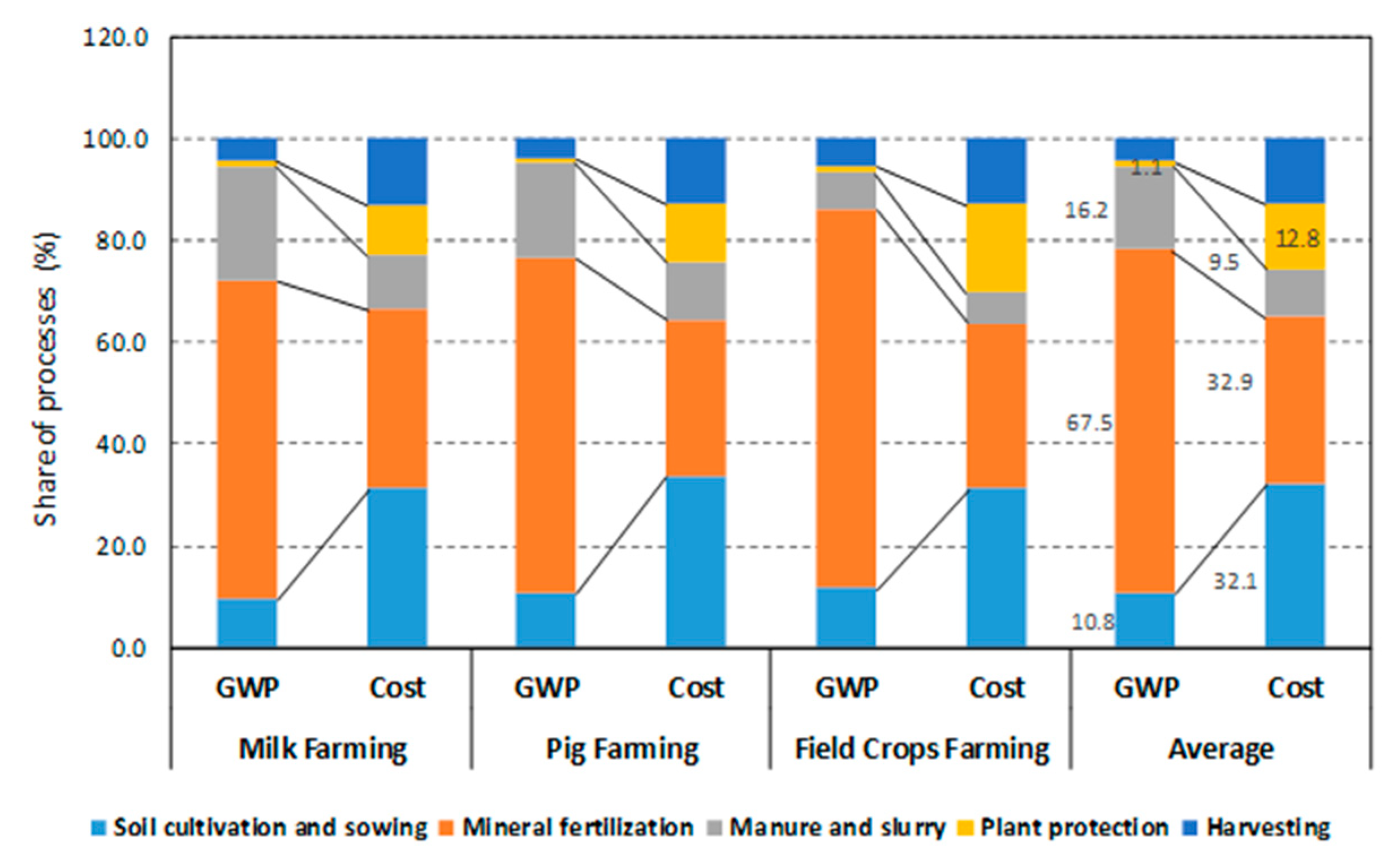
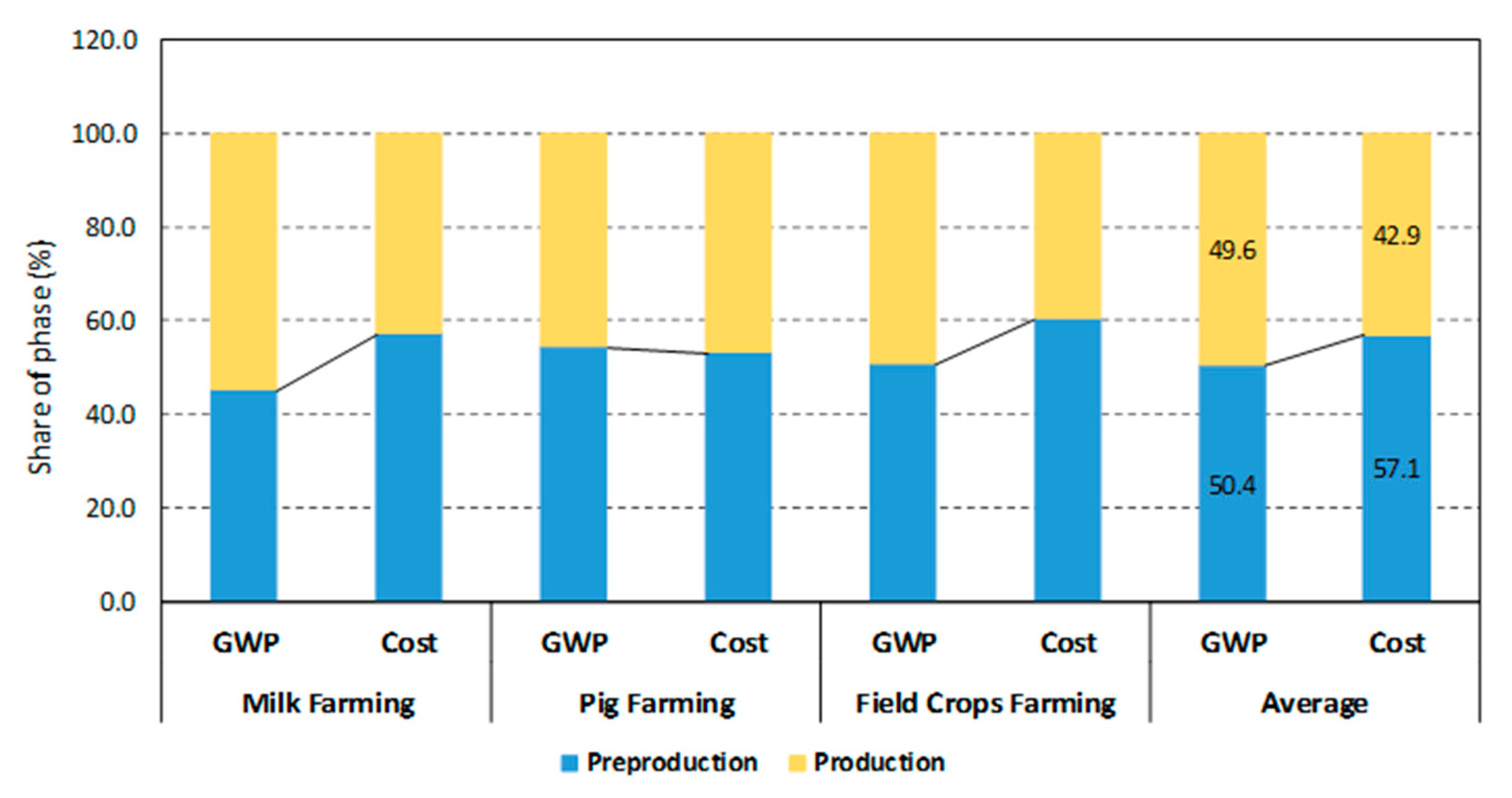
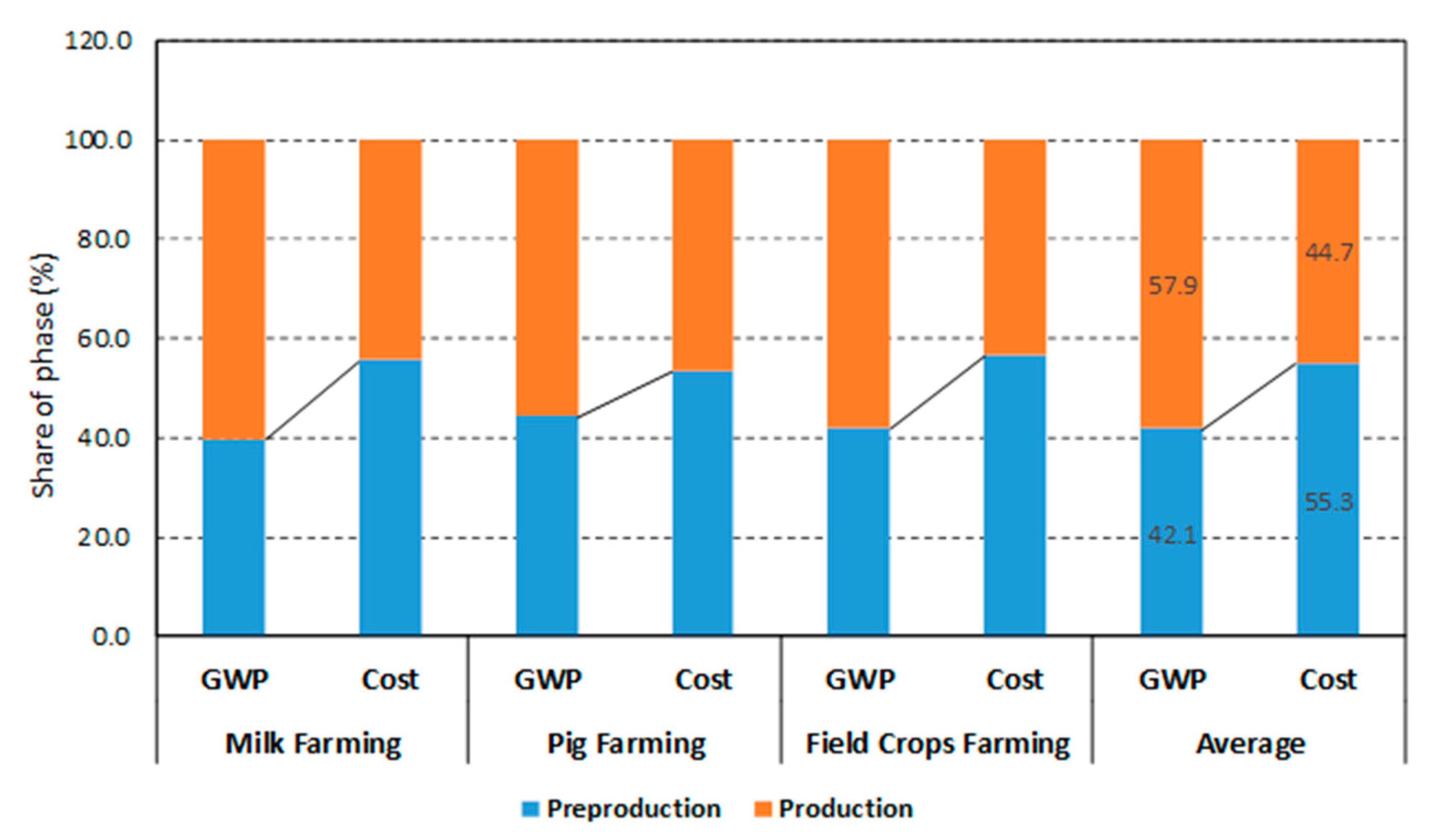
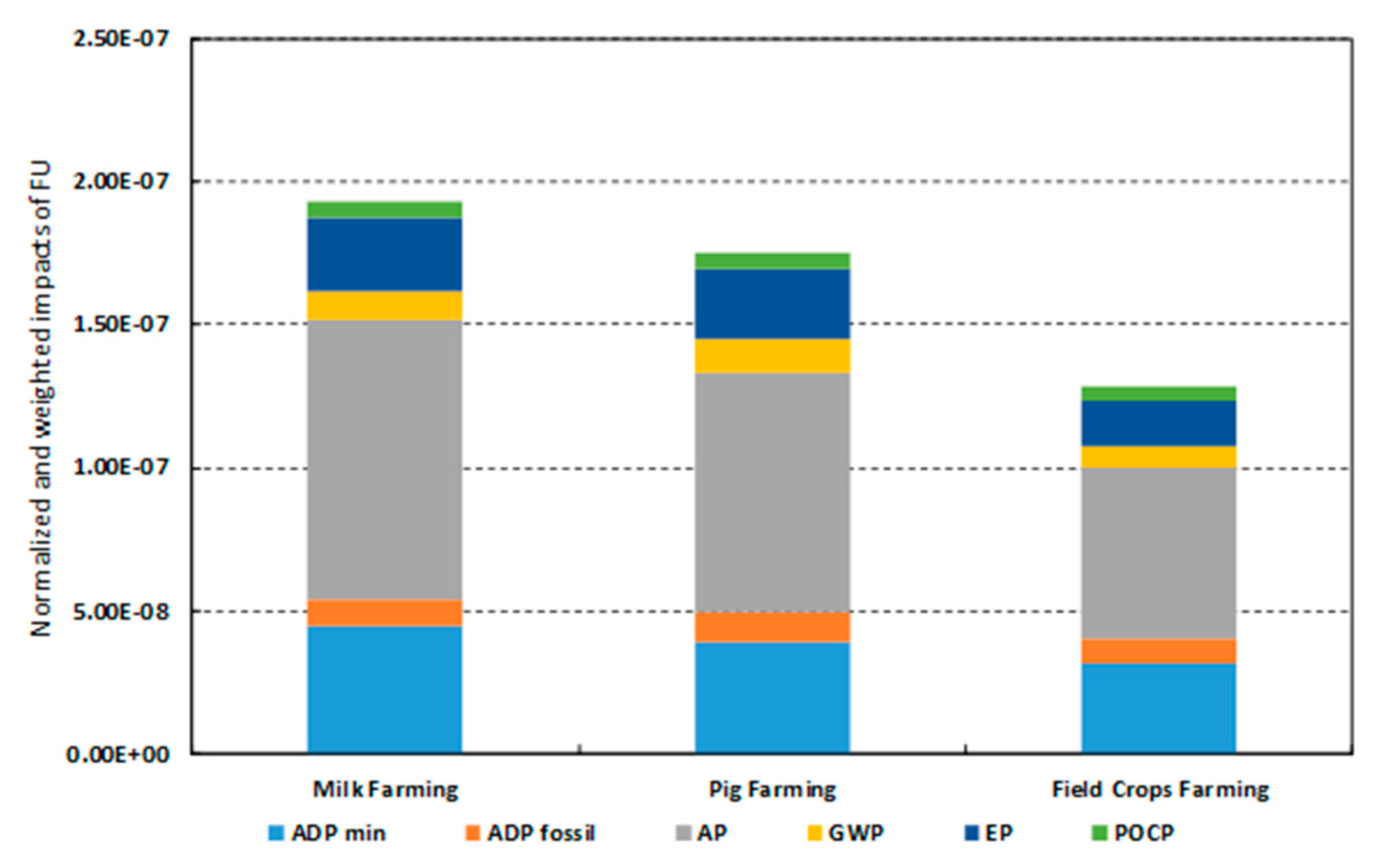
| Specification | Farming Type | ||
|---|---|---|---|
| Milk | Pig | Field Crops | |
| UAA 1, ha | 53.9 (12.0–338.7) | 52.1 (15.2–104.1) | 61.8 (11.9–173.5) |
| Winter rape sowing area, ha | 5.4 (0.0–18.9) | 8.0 (0.0–12.0) | 11.9 (0.0–52.0) |
| Grain maize sowing area, ha | 1.4 (0.0–18.9) | 0.8 (0.0–8.0) | 9.2 (0.0–52.0) |
| Stocking rate, LSU 2 ha−1 UAA | 1.44 (0.57–4.00) | 0.91 (0.30–1.77) | 0.00 (0.00–0.04) |
| Rapeseed yield, Mg ha−1 | 3.1 (2.6–3.6) | 3.4 (3.0–4.2) | 2.6 (1.0–4.0) |
| Grain maize yield, Mg ha−1 | 9.0 (7.9–10.0) | 6.6 (6.0–7.1) | 9.8 (5.8–13.0) |
| NPK 3 fertilization, kg NPK ha−1 UAA | 231.0 (158.4–381.8) | 240.5 (73.5–516.9) | 256.2 (122.4–399.0) |
© 2020 by the authors. Licensee MDPI, Basel, Switzerland. This article is an open access article distributed under the terms and conditions of the Creative Commons Attribution (CC BY) license (http://creativecommons.org/licenses/by/4.0/).
Share and Cite
Baum, R.; Bieńkowski, J. Eco-Efficiency in Measuring the Sustainable Production of Agricultural Crops. Sustainability 2020, 12, 1418. https://doi.org/10.3390/su12041418
Baum R, Bieńkowski J. Eco-Efficiency in Measuring the Sustainable Production of Agricultural Crops. Sustainability. 2020; 12(4):1418. https://doi.org/10.3390/su12041418
Chicago/Turabian StyleBaum, Rafał, and Jerzy Bieńkowski. 2020. "Eco-Efficiency in Measuring the Sustainable Production of Agricultural Crops" Sustainability 12, no. 4: 1418. https://doi.org/10.3390/su12041418
APA StyleBaum, R., & Bieńkowski, J. (2020). Eco-Efficiency in Measuring the Sustainable Production of Agricultural Crops. Sustainability, 12(4), 1418. https://doi.org/10.3390/su12041418





